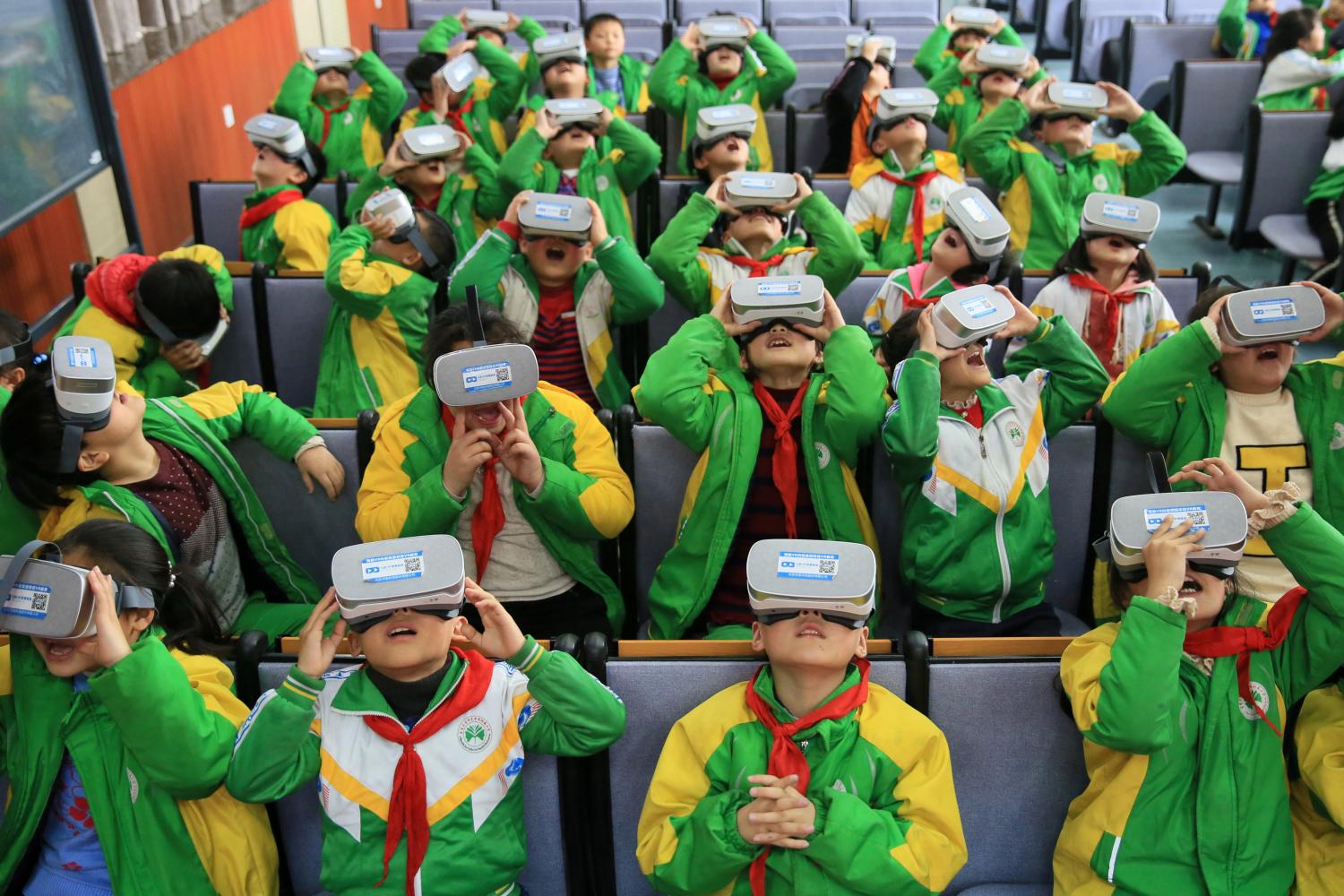This report is part of “A Blueprint for the Future of AI,” a series from the Brookings Institution that analyzes the new challenges and potential policy solutions introduced by artificial intelligence and other emerging technologies.
Artificial intelligence (AI) and emerging technologies (ET) are poised to transform modern society in profound ways. As with electricity in the last century, AI is an enabling technology that will animate everyday products and communications, endowing everything from cars to cameras with the ability to interact with the world around them, and with each other. These developments are just the beginning, and as AI/ET matures, it will have sweeping impacts on our work, security, politics, and very lives.1
These technologies are already impacting the world around us, as Darrell West and I wrote in our April 2018 piece “How artificial intelligence is transforming the world,” and I highly recommend that anyone just discovering the topic of AI policy read it thoroughly. There, Darrell and I describe several important implications related to AI/ET, but chief among them is that these technology developments are on the cusp of ushering in a true revolution in human affairs at an increasingly fast pace.
As AI continues to influence and shape existing industries and allows new ones to take root, its macro-level impact, particularly in the realm of economics, will become more and more apparent. Control over the research and development of AI will become increasingly vital, and the winners of this upcoming AI-defined era in human history will be the countries and companies that can create the most powerful algorithms, assemble the most talent, collect the most data, and marshal the most computing power. This is the next great technology race of our generation and the stakes are high, particularly for the United States. If American society is to embrace the full range of social and political changes that these technologies will introduce, then it is the education and training we provide our youth and workers that will fuel the engines of future AI, and therefore geopolitical success.
It is the education and training we provide our youth and workers that will fuel the engines of future AI, and therefore geopolitical success.
I’ve studied and written extensively about the effects of AI/ET on the evolving character of war toward a concept I’ve called hyperwar—or, a new era of warfare in which, through AI, the speed of decision-making is faster than anything that has come before. At a superficial level, this topic often devolves into a discussion of “killer robots,” or at the very least, the impending use of AI in lethal autonomous weaponry. While those discussions are relevant and inextricably linked, they represent a narrow understanding of the greater issues at hand. The concern over AI’s potential or theoretical military applications must not distract us from how far-reaching the impact of AI will be in nearly all other policy domains. Health care, education, agriculture, energy, finance, and yes, national security, will all be reshaped in some way by AI—with education being the pivot point around which the future of the United States revolves. This is not solely a matter of social redress, but, in fact, a larger national issue.
A future in which the United States is second in the race for AI technology would create a situation of national technological and digital/cyber inferiority, which could in turn result in national strategic subservience.
The way we use education to prepare our next-generation of leaders will directly determine whether the U.S. retains its leadership in critical fields of relevance in the emerging digital environment. Without a sufficiently educated population and workforce, the U.S. likely will slip behind other states for whom AI/ET is not only means for improved social organization, but for strategic superiority, and ultimately digital and physical conquest. A future in which the United States is second in the race for AI technology would create a situation of national technological and digital/cyber inferiority, which could in turn result in national strategic subservience—something simply unimaginable.
Many Americans grew up with the understanding that the American capacity to fight and win a nuclear war was defined by its superiority in the Strategic Triad, the three legs of our strategic deterrence: our missile squadrons, our bomber fleet, and our ballistic missile submarines. Behind that dizzying array of hardware was the undisputed power of U.S. intellectual and technical capabilities, and behind that was a near unlimited supply of talented engineers, each trained by a system of education undisputed in its excellence. That system was built from the ground up to produce crucial STEM (science, technology, engineering, and math) protégés in the quantities needed to ensure American strategic superiority, which contributed directly to the U.S. and its allies prevailing in the Cold War. For the health of our American way of life, our competitive advantage, and the strategic security of our nation, the basis for tomorrow’s system of education must reflect a deliberately tuned and calibrated system that proactively emphasizes AI/ET, big data analytics, and super-computing.
Unfortunately, in both relative and absolute terms, the U.S. is falling behind in the race for superiority in these key technologies. Where the U.S. strategic advantage of the 20th Century was secured by American nuclear superiority, U.S. superiority in the 21st Century will likely be preserved, safeguarded, and sustained through a system of education that envisages the changes necessary and sufficient to embrace and apply relevant technologies. It will also be underwritten by educators who grasp the profound shifts in the pedagogical skills essential to the educational needs of the 21st Century.

The need to adapt is great—and for this system to be fully embraced it must come in the form of a comprehensive and national U.S. strategy for education in the digital age, to include the resources necessary to bring education into the digital classroom, and to educate and train entire generations of educators to be relevant in the 21st Century and beyond. The United States must at all costs preserve its position of primacy in AI, big data, and super-computing, and that can only be done through a highly educated population and derivative work force, and even-further through leaders who understand these issues on a fundamental level and have the political will to develop and resource a comprehensive plan for reimagining our national education efforts.
In thinking about the essence of a U.S. national education strategy adapted to the digital age, several important questions arise pertaining to the way we think about education and develop the next generation of leaders:
1. What will be the implications for how we educate, train, and develop teachers?
A discussion on the impact of AI on education will point dramatically to those who facilitate the process in our schools. The very term “teacher” may be insufficient to adequately capture the role of this key individual in the educational experience. Teaching and learning requirements may be substantially re-ordered and the dynamic of learning versus teaching in an AI-based system of education will be very different. This will raise important questions about requirements for teaching degrees and related certificates in this new environment, and the necessary adaptation of the science of pedagogy to these changes. Ultimately, the key question will be “are the teachers of today ready to develop the leaders we will need tomorrow?” A difficult question, to be sure, and the answer today is no.
2. What will a AI-based classroom look like?
With AI, every aspect of the traditional learning environment is up for reimagining.
With AI, every aspect of the traditional learning environment is up for reimagining. Will the classroom continue to be a physical space? Or instead, will it be a virtual “space” using networked augmented or virtual reality technologies? The answer is yes to both, and the student in tomorrow’s AI-based educational experience will be exposed to an immersive, digital education heretofore unimaginable. The distributed, networked, virtual reality classroom is both enormously exciting, and, at the same time, frightening for its potential. There are major challenges to measuring success in an AI-based educational process. For instance, if our students can become more deeply involved in the pathways of their own learning through AI, measurement will occur moment to moment, as well as the success of remediation. In a best-case scenario, we will know at the end of each student’s day if s/he is meeting requirements and quickly correct deficiencies as necessary to stay on track. Worst-case—students already falling behind will be left behind entirely by this new AI-based reality. In any case, there are profound moral questions to consider with a system such as this, and policymakers must understand the underlying dynamics of the technologies at play if they are to fully support society.
3. What will this kind of system of education do to reduce inequalities in our society?
One of the most profound aspects of education in the AI environment is that these technologies could unleash the potential and productivity of a huge sector of American and global society hitherto constrained by their educational experience and resulting lack of opportunity. Local governments, schools, and especially the private sector will need to routinely intersect to create synergy and symbiosis to enhance our educational processes. Through the AI-powered digital space, “opportunity for all” may become a reality for those who previously had little means of achieving their own piece of the American Dream. The profoundly limiting feature of these opportunities lies in internet and 4G and 5G penetration within the United States, and the sometimes appallingly scarce educational resources committed in some areas in America. There are large segments of the U.S. where our education systems, and our youth, have limited-to-no access to the internet and to Wi-Fi. If we hope to achieve our digital potential, and to continue to maintain our lead in AI and other emerging technologies, a national program to bring Wi-Fi and the internet to all our citizens is absolutely essential, and will in any case help to close the sometimes yawning gaps created by racial and income inequality in the U.S.
AI/ET promise to usher in a bold new era of human history, one where the machines we create will oftentimes be smarter, faster, and more powerful than those who created them. This reality has profound implications for the field of education and introduces complex ethical, legal, and societal implications that academics, policymakers, and average citizens alike will need to contend with as every aspect of society reshapes around them. Further, the United States risks strategic inferiority if it does not embrace a full reconsideration of education in the digital environment, to include a comprehensive strategy for reimagining our education system at the national level. Today, we are not training our young leaders with the tools required to be successful in the digital age, and that has deeply troubling implications for the future of American society. Nevertheless, just as the United States persevered through the Cold War through technological superiority, I am hopeful that the 21st Century will yet again be one defined by American leadership—with our best and brightest leading the charge.
John R. Allen is a member of the Board of Advisors of Amida Technology and on the Board of Directors of Spark Cognition. Both companies work in fields discussed in this piece.
-
Footnotes
- An earlier version of this paper was published in the Brown Journal of Philosophy, Politics, and Economics at https://www.brownjppe.com/john-allen-feature







